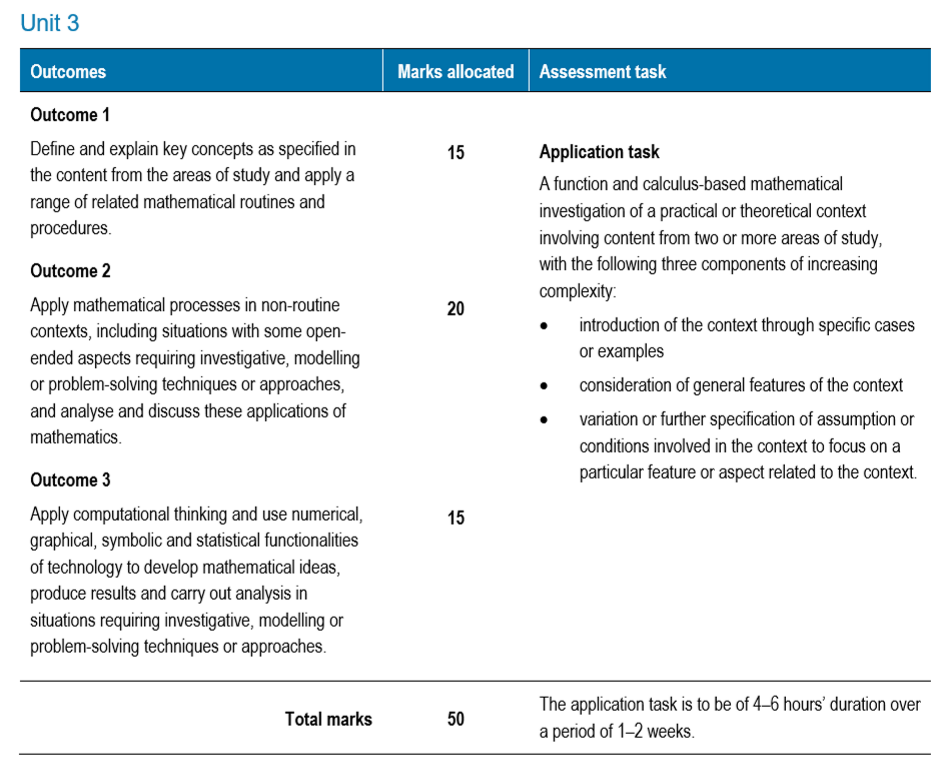Mathematical Methods
Unit 3-4
Entry
VCE Mathematical Methods Units 3 and 4 assumes successful completion of Mathematical Methods Units 1 and 2, which covers the assumed knowledge and skills for this course.
Subject Overview
Mathematical Methods Units 3 and 4 are completely prescribed and extend the introductory study of simple elementary functions of a single real variable to include combinations of these functions - algebra, calculus, probability and statistics, and their applications - in a variety of practical and theoretical contexts. Units 3 and 4 consist of the areas of study ‘Functions and graphs’, ‘Calculus’, ‘Algebra’ and ‘Probability and statistics’, which must be covered in progression from Unit 3 to Unit 4 with an appropriate selection of content for each of Unit 3 and Unit 4. Assumed knowledge and skills for Mathematical Methods Units 3 and 4 are contained in Mathematical Methods Units 1 and 2 and will be drawn on, as applicable, in the development of related content from the areas of study, as well as key knowledge and skills for the outcomes of Mathematical Methods Units 3 and 4.
For Unit 3, a selection of content would typically include the areas of study ‘Functions and graphs’ and ‘Algebra’, applications of derivatives and differentiation, and identifying and analysing key features of the functions and their graphs from the ‘Calculus’ area of study. For Unit 4, this selection would typically consist of remaining content from the ‘Functions and graphs’, ‘Calculus’ and ‘Algebra’ areas of study, the study of random variables, and discrete and continuous probability distributions and the distribution of sample proportions. For Unit 4, the content from the ‘Calculus’ area of study would be likely to include the treatment of anti-differentiation, integration, the relation between integration and the area of regions specified by lines or curves described by the rules of functions, and simple applications of this content.
In undertaking these units, students are expected to be able to apply techniques, routines and processes involving rational and real arithmetic, sets, lists and tables, diagrams and geometric constructions, algebraic manipulation, equations, graphs, differentiation, anti-differentiation, integration and inference - with and without the use of technology. They should have facility with relevant mental and by-hand approaches to estimation and computation. The use of numerical, graphical, geometric, symbolic and statistical functionality of technology for teaching and learning mathematics, for working mathematically, and in related assessment, is to be incorporated throughout each unit as applicable.
Assessment
Satisfactory completion
The award of satisfactory completion for a unit is based on a decision that the student has demonstrated achievement of the set of outcomes specified for the unit. This decision will be based on the teacher’s assessment of the student’s performance on assessment tasks designated for the unit. Students are also required to meet the minimum work requirements for each unit as well as the TC VCE minimum attendance requirement of 80 per cent.
A non-satisfactory outcome for Unit 3 or Unit 4 implies that the student will not receive a study score for this subject.
Assessment
The Victorian Curriculum and Assessment Authority will supervise the assessment of all students undertaking Units 3 and 4. In the study of VCE Mathematics, students’ level of achievement will be determined by School-assessed Coursework (SACs) and two end-of-year examinations.
Unit 3 School-assessed Coursework: 20 %
Unit 4 School-assessed Coursework: 20 %
Examination 1: 20 %
Examination 2: 40 %
School-based assessment
UNIT 3
UNIT 4
External assessment
Examination 1:
Description
This examination comprises short-answer and some extended-answer questions covering all areas of study in relation to Outcome 1. It is designed to assess students’ knowledge of mathematical concepts, their skills in carrying out mathematical algorithms without the use of technology and their ability to apply concepts and skills.
Conditions
The examination will be one hour in duration and no technology (calculators or software) or notes of any kind are permitted. A sheet of formulas will be provided with the examination. VCAA examination rules will apply.
Contribution to final assessment
The examination will contribute 20%.
Examination 2:
Description
This examination comprises multiple-choice questions and extended-answer questions covering all areas of study in relation to all three outcomes, with an emphasis on Outcome 2. The examination is designed to assess students’ ability to understand and communicate mathematical ideas and to interpret, analyse and solve both routine and non-routine problems.
Conditions
The examination will be two hours in duration and student access to an approved technology with numerical, graphical, symbolic and statistical functionality will be assumed. One bound reference - text (which may be annotated) or lecture pad - may be brought into the examination. VCAA examination rules will apply.
Contribution to final assessment
The examination will contribute 40 %



